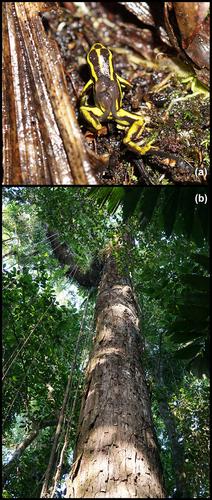当前位置:
X-MOL 学术
›
Biotropica
›
论文详情
Our official English website, www.x-mol.net, welcomes your
feedback! (Note: you will need to create a separate account there.)
Chemical defenses shift with the seasonal vertical migration of a Panamanian poison frog
Biotropica ( IF 1.8 ) Pub Date : 2020-09-06 , DOI: 10.1111/btp.12842 Edmund W. Basham 1 , Ralph A. Saporito 2 , Macario González‐Pinzón 3 , Angel Romero‐Marcucci 3 , Brett R. Scheffers 1, 4
Biotropica ( IF 1.8 ) Pub Date : 2020-09-06 , DOI: 10.1111/btp.12842 Edmund W. Basham 1 , Ralph A. Saporito 2 , Macario González‐Pinzón 3 , Angel Romero‐Marcucci 3 , Brett R. Scheffers 1, 4
Affiliation

|
Dendrobatid poison frogs sequester lipophilic alkaloids from their arthropod prey to use as a form of chemical defense. Some dendrobatid frogs seasonally migrate between the leaf litter of the forest floor in the dry season to the canopy in the wet season, which may yield differences in prey (arthropods) and therefore alkaloid availability over space and time. Here, we document a seasonal vertical migration of Andinobates fulguritus (the yellow‐bellied poison frog) from ground to canopy between dry and wet seasons. We observed turnover in alkaloid composition between seasons and found that dry season frogs contained a lower relative quantity of alkaloids; however, there was no change in alkaloid richness between seasons. The 77 alkaloids of 13 structural classes identified in this population appear to be derived mostly from mites and ants, though the two most common alkaloids were mite derived. Our observed shifts in defensive profiles are consistent with well‐documented turnover in mite and ant communities between seasons and vertical strata. As climate change is expected to lengthen and strengthen dry seasons in many tropical regions, our results suggest that arboreal poison frogs forced to the ground for longer periods of time may see a shift in the abundance of alkaloids, possibly decreasing their defensive potential. This study provides further predictions for the wide‐reaching effects of climate change, even as nuanced as charismatic poison frogs losing their poisons.
中文翻译:

化学防御随着巴拿马毒蛙的季节性垂直迁移而转移
Dendrobatid毒蛙将节肢动物的猎物中的亲脂性生物碱隔离,用作化学防御的一种形式。一些树栖蝠蛙在干燥季节在林地的树叶凋落物之间季节性地迁移到雨季在冠层之间迁移,这可能导致猎物(节肢动物)的差异,因此生物碱在空间和时间上的可利用性不同。在这里,我们记录了Andinobates fulguritus的季节性垂直迁移(黄腹毒蛙)在干燥和潮湿的季节从地面到树冠。我们观察了季节之间生物碱成分的更新,发现旱季青蛙所含生物碱的相对含量较低。然而,四季之间生物碱的丰富度没有变化。尽管这两种最常见的生物碱是螨虫衍生的,但在该种群中鉴定出的13个结构类别的77个生物碱似乎主要来自螨虫和蚂蚁。我们观察到的防御性态势的变化与季节和垂直层之间螨虫和蚂蚁群落的周转记录相一致。由于预计气候变化会延长许多热带地区的干旱季节并加强干旱季节,因此我们的结果表明,被迫长期搁置在地面上的树蛙毒蛙可能会看到生物碱含量的变化,可能会降低他们的防守潜力。这项研究为气候变化的广泛影响提供了进一步的预测,即使像魅力十足的毒蛙失去毒物一样细致入微。
更新日期:2020-09-06
中文翻译:

化学防御随着巴拿马毒蛙的季节性垂直迁移而转移
Dendrobatid毒蛙将节肢动物的猎物中的亲脂性生物碱隔离,用作化学防御的一种形式。一些树栖蝠蛙在干燥季节在林地的树叶凋落物之间季节性地迁移到雨季在冠层之间迁移,这可能导致猎物(节肢动物)的差异,因此生物碱在空间和时间上的可利用性不同。在这里,我们记录了Andinobates fulguritus的季节性垂直迁移(黄腹毒蛙)在干燥和潮湿的季节从地面到树冠。我们观察了季节之间生物碱成分的更新,发现旱季青蛙所含生物碱的相对含量较低。然而,四季之间生物碱的丰富度没有变化。尽管这两种最常见的生物碱是螨虫衍生的,但在该种群中鉴定出的13个结构类别的77个生物碱似乎主要来自螨虫和蚂蚁。我们观察到的防御性态势的变化与季节和垂直层之间螨虫和蚂蚁群落的周转记录相一致。由于预计气候变化会延长许多热带地区的干旱季节并加强干旱季节,因此我们的结果表明,被迫长期搁置在地面上的树蛙毒蛙可能会看到生物碱含量的变化,可能会降低他们的防守潜力。这项研究为气候变化的广泛影响提供了进一步的预测,即使像魅力十足的毒蛙失去毒物一样细致入微。











































 京公网安备 11010802027423号
京公网安备 11010802027423号